
Palmerston North is a city in the North Island of New Zealand and the seat of the Manawatū-Whanganui region. Located in the eastern Manawatu Plains, the city is near the north bank of the Manawatū River, 35 km (22 mi) from the river's mouth, and 12 km (7 mi) from the end of the Manawatū Gorge, about 140 km (87 mi) north of the capital, Wellington. Palmerston North is the country's eighth-largest urban area, with an urban population of 83,100. The estimated population of Palmerston North city is 92,500.
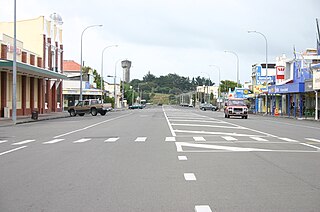
Foxton is a town in the Manawatū-Whanganui region of New Zealand - on the lower west coast of the North Island, in the Horowhenua district, 30 km (19 mi) southwest of Palmerston North and just north of Levin. The town is located close to the banks of the Manawatū River. It is situated on State Highway 1, roughly in the middle between Tongariro National Park and Wellington.

Manawatū-Whanganui is a region in the lower half of the North Island of New Zealand, whose main population centres are the cities of Palmerston North and Whanganui. It is administered by the Manawatū-Whanganui Regional Council, which operates under the name Horizons Regional Council.

Manawatū District is a territorial authority district in the Manawatū-Whanganui local government region in the North Island of New Zealand, administered by Manawatū District Council. It includes most of the area between the Manawatū River in the south and the Rangitīkei River in the north, stretching from slightly south of the settlement of Himatangi in the south, to just south of Mangaweka in the north, and from the Rangitīkei River to the top of the Ruahine Range in the east. It does not include the Foxton area and the mouth of the Manawatū River, or Palmerston North City. Its main town is Feilding. The district has an area of 2,624 km².
Longburn is a rural settlement just outside Palmerston North in the Manawatū-Whanganui area of New Zealand. Made up of large dairy processing plants Longburn is often mistaken to be a small township and not seen as a large satellite town of Palmerston North. The township is home to both Longburn School and Longburn Adventist College.

Harry Howard Barton Allan was a New Zealand teacher, botanist, scientific administrator, and writer. Despite never receiving a formal education in botany, he became an eminent scientist, publishing over 100 scientific papers, three introductory handbooks on New Zealand plants, and completing the first volume of a flora in his lifetime.
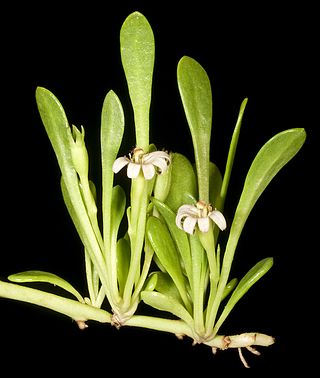
Goodenia radicans, commonly known as remuremu, swampweed, bonking grass, or its former botanical name Selliera radicans, is a creeping, herbaceous plant species found in New Zealand, Australia and Chile. It is the most observed Goodenia on iNaturalist in New Zealand, and is indigenous to New Zealand and Australia. Only one other Goodenia is native to New Zealand, the severely range-restricted Goodenia heenanii.

Goodenia paradoxa, commonly known as spur velleia or spur goodenia, is a species of flowering plant in the family Goodeniaceae, and is endemic to Australia. It is a perennial herb covered with soft hairs, and has egg-shaped to elliptic leaves with toothed edges and yellow flowers on an ascending flowering stem.

Goodenia caroliniana is a species of flowering plant in the family Goodeniaceae, and is endemic to eastern Australia. It is a perennial herb with egg-shaped to lance-shaped leaves with toothed edges and the narrower end toward the base, and erect flowering stems up to 50 cm (20 in) high and yellow flowers.
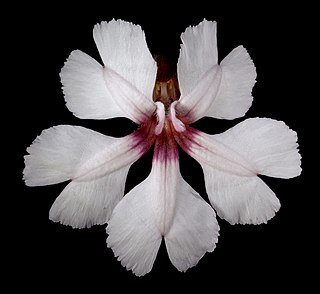
Goodenia rosea, commonly known as pink velleia, is a species in the family Goodeniaceae and is endemic to inland areas of Western Australia. It is a perennial herb with lance-shaped to toothed or pinnatisect leaves, pink, lilac or white flowers on an ascending flower stem, and compressed fruit.

Goodenia connata, commonly known as cup velleia, is a species of flowering plant in the family Goodeniaceae, and is found in all mainland states and territories of Australia. It is a glabrous annual herb with a rosette of leaves at the base, and ascending flowering stems with yellow, brownish-yellow or white flowers, often with mauve markings.
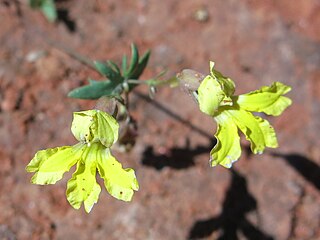
Goodenia glabrata, commonly known as pee the bed, is a species of flowering plant in the family Goodeniaceae and is native to mainland Australia. It is a mostly glabrous annual herb with ascending flowering stems, oblong to lance-shaped leaves with toothed edges, and yellow flowers.
Clifford Simpson was a New Zealand middle-distance athlete who represented his country at the 1950 British Empire Games. He also played representative rugby union for South Otago.

Eric Gordon Fletcher was a rugby union and rugby league player. He represented the New Zealand rugby league team in 1 test against Australia in 1935. In the process he became the 239th player to represent New Zealand. Fletcher also played rugby union representatively for Manawatu province and the combined Manawatu-Horowhenua side whilst a member of the Old Boys and later Massey College club sides. After moving to Auckland he also represented Auckland in a sub-union match with Thames. After switching to rugby league he played for the Richmond Rovers club and played for Auckland, and Auckland Province. He was also a talented cricketer and played a handful of games for Manawatu in his younger years. After retiring from rugby he played representative golf in the Manawatu region and in 1939 played in the New Zealand Golf Open.

The Central Federation League is an amateur status league competition run by Central Football for association football clubs located in the central region of the North Island, New Zealand. It is currently in the third level of the New Zealand football league system, below the Central League administered by Capital Football and is entered by clubs from the Taranaki, Manawatū-Whanganui, Hawke's Bay and Gisborne districts.

Goodenia mystrophylla is a flowering plant in the family Goodeniaceae and is native to eastern Australia and New Guinea. It is a small, perennial herb with lance-shaped leaves, prostrate or low-lying flower stems and yellow flowers with purplish markings.

Goodenia brendannarum is a species of flowering plant in the family Goodeniaceae, and is endemic to a small area in the south-west of Western Australia. It is a perennial herb with woody stems, crowded, narrowly egg-shaped leaves with toothed edges, and erect flowering stems and orange-yellow and red flowers.
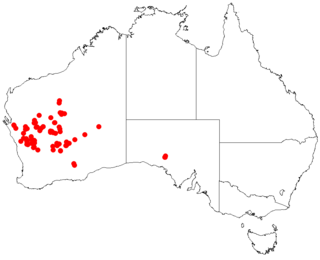
Goodenia capillosa, commonly known as hispid velleia, is a species of flowering plant in the family Goodeniaceae and is native to inland areas of Western Australia and South Australia. It is an annual herb with covered with soft hairs, and has narrowly egg-shaped to narrowly elliptic leaves with toothed or lyre-shaped edges, and yellow flowers.

Goodenia parvisepta is a species of flowering plant in the family Goodeniaceae and is endemic to a small area of New South Wales. It is a glabrous perennial herb with erect flowering stems, lance-shaped leaves with toothed or lobed edges, and yellow flowers.

Goodenia perfoliata is a species of flowering plant in the family Goodeniaceae and is endemic to a small area of New South Wales. It is a mostly glabrous, perennial herb with erect flowering stems, lance-shaped leaves with sometimes deeply-toothed edges, and yellow flowers with bracteoles joined to form a disc-like funnel.


















